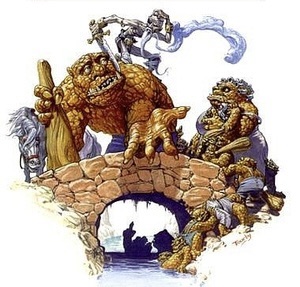
There is a peculiar form of reasoning that emerges when someone discovers they are standing at a chokepoint.
It goes like this: “Networks need hubs” somehow always becomes “and therefore I’m destiny.”
The Patrician of Ankh-Morpork had observed this phenomenon many times. It was especially common among the heads of the various Guilds, each of whom had independently concluded that their particular Guild was, when you really thought about it, the load-bearing pillar upon which all of civilization rested. The head of the Seamstresses’ Guild had explained it to him once, at length. The head of the Assassins’ Guild had explained it more briefly—but with visual aids.
What was funny—funny in the way a guillotine is funny when you’re standing beneath it—was how structural observations about bottlenecks tended to be most compelling to the people currently beta-testing them.
Take, for instance, the troll standing in the middle of the only bridge across the Ankh. Over the years, his toll had evolved in fascinating ways. It began as a simple copper piece per crossing—reasonable enough, since someone had to maintain the bridge, and trolls were traditionally good at standing still for long periods.
But then the troll attended a seminar on value capture. He learned about price discrimination and how different customers have different willingness to pay. The toll became a copper for peasants, two coppers for merchants, and a silver for anyone wearing jewelry. This was only fair, the troll explained, because wealthy people derived more utility from the bridge. They had more to transport, more urgent business on the other side. The bridge was merely capturing its fair share of the value it created.
Then came the introduction of the Bridge Token system. Now you couldn’t simply pay the toll—you had to buy tokens in advance, which could only be purchased from the troll’s authorized dealers (who happened to be his cousins). The tokens appreciated in value as more people needed to cross, which was only natural, the troll said, because the bridge was generating wealth and the tokens represented fractional ownership in that value creation.
Eventually, some citizens pointed out that the troll hadn’t actually built the bridge. The bridge had been there for centuries. The troll had simply… sat on it.
“Ah,” said the troll—who had by now hired a consulting wizard to assist with messaging—“but you’re missing the innovation. Anyone can build a bridge. What I provide is liquidity. Price discovery. Coordination. Someone has to aggregate all these crossing-demands and match them efficiently with bridge-supply. That’s the service layer.”
When asked whether the service layer might be charging rather a lot for what appeared to be sitting down, the troll would patiently explain that this revealed a fundamental misunderstanding of information theory and coordination costs. Had they read the literature on Dunbar’s number? Did they understand the computational complexity of n-to-n bridge-crossing arrangements?
The troll never seemed to wonder whether perhaps the bridge was the important bit, and he was simply the large obstacle currently sitting on it—an obstacle that had somehow convinced everyone that the obstacle was the bridge, or at least the only part that mattered.
Certain claims about coordination constraints did heavy lifting when they morphed into “…and that’s why my position is theologically inevitable, optimal.” One might almost suspect divine providence was involved, if divine providence weren’t so remarkably consistent about blessing people already sitting on large piles of money.
Mathematics, the Patrician reflected, could explain that bridges exist. It could even explain why bridges must exist, given the unfortunate persistence of rivers and the equally unfortunate inability of most citizens to breathe underwater. What mathematics couldn’t explain—at least not without adding several variables mathematicians found aesthetically displeasing—was who gets to be the troll, what the toll should be, or whether perhaps we might consider building a different bridge. Or several bridges. Or teaching people to swim.
Necessity, he had discovered, was not the same as sufficiency. Sufficiency was not the same as this specific instantiation, with these specific actors, extracting this specific rent, at this specific margin, forever and ever, amen.
And yet somehow, whenever anyone pointed this out, they were accused of not understanding graph theory.
The Patrician smiled thinly and made a mental note to have someone check whether the Troll Bridge was still structurally sound—or, more to the point, whether the troll was.
He made a final scribble, tapping the quill lightly: After all, bridges could be rebuilt. Trolling was, in the grand scheme of things, sadly, a service layer.
Leave a Reply